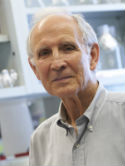Role of kit-ligand in proliferation and suppression of apoptosis in mast cells: Basis for radiosensitivity of white spotting and steel mutant mice Journal Article
| Authors: | Yee, N. S.; Paek, I.; Besmer, P. |
| Article Title: | Role of kit-ligand in proliferation and suppression of apoptosis in mast cells: Basis for radiosensitivity of white spotting and steel mutant mice |
| Abstract: | The receptor tyrosine kinase Kit and its cognate ligand KL/steel factor are encoded at the white spotting (W) and Steel (Sl) loci of the mouse, respectively. Mutations at both the W and the Sl loci affect hematopoiesis including the stem ceil hierarchy, erythropoiesis, and mast cells, as well as gametogenesis and mdanogenesis. In addition, mutant mice display an increased sensitivity to lethal doses of irradiation. The role of KL/c-kit in ceil proliferation and survival under conditions of growth factor-deprivation and γ-irradiation was studied by using bone marrow-derived mast cells (BMMC) as a modal. Whereas apoptosis induced by growth factor deprivation in BMMC is a stochastic process and follows zero order kinetics, γ-irradiation-induced apoptosis is an inductive process and follows higher order kinetics. In agreement with these results, γ-irradiation-induced apoptosis in BMMC was shown to be dependent on p53 whereas apoptosis induced by deprivation is partly dependent on p53, implying that there are other mechanisms mediating apoptosis in KL-deprived BMMC. In the presence and in the absence of serum, KL stimulated proliferation by promoting cell cycle progression. The presence of KL was required only daring the early part of the G1 phase for entry into the S phase. At concentrations lower than those required for proliferation, KL suppressed apoptosis induced by both growth factor-deprivation and 3,-irradiation, and internudeosomal DNA fragmentation characteristic of apoptosis. The ability of KL to suppress apoptosis was independent of the phase of the ceil cycle in which the ceils were irradiated and suppression of apoptosis was a prerequisite for subsequent cell cycle progression. Moreover, addition of KL to γ-irradiated and growth factor-deprived cells could be ddayed for up to I h after irradiation or removal of growth factors when cells became irreversibly committed to apoptosis. KL and IL-3 induce suppression of apoptosis in mast calls by different mechanisms based on the observations of induction of kl-2 gene expression by IL-3 but not by KL. It is proposed that the increased sensitivity of W and SI mutant mice to lethal irradiation results from paucity of the apoptosis suppressing and proliferative effects of KL. © 1994, Rockefeller University Press., All rights reserved. |
| Keywords: | gene mutation; proto-oncogene proteins; nonhuman; comparative study; flow cytometry; cell proliferation; animal cell; mouse; animal; mice; cell survival; cells, cultured; cell cycle; cell division; stem cell factor; proto oncogene; apoptosis; mice, mutant strains; dose-response relationship, drug; protein p53; mice, inbred c57bl; dose-response relationship, radiation; kinetics; growth regulation; radiosensitivity; cell adhesion molecules; receptor protein-tyrosine kinases; cell protection; radiation protection; mast cell; mast cells; gamma rays; interleukin 3; priority journal; article; support, non-u.s. gov't; support, u.s. gov't, p.h.s.; hematopoietic cell growth factors; proto-oncogene protein c-kit; receptors, colony-stimulating factor; lichen sclerosus et atrophicus |
| Journal Title: | Journal of Experimental Medicine |
| Volume: | 179 |
| Issue: | 6 |
| ISSN: | 0022-1007 |
| Publisher: | Rockefeller University Press |
| Date Published: | 1994-06-01 |
| Start Page: | 1777 |
| End Page: | 1787 |
| Language: | English |
| DOI: | 10.1084/jem.179.6.1777 |
| PROVIDER: | scopus |
| PMCID: | PMC2191529 |
| PUBMED: | 7515099 |
| DOI/URL: | |
| Notes: | Export Date: 14 January 2019 -- Article -- Source: Scopus |
Altmetric
Citation Impact
BMJ Impact Analytics
Related MSK Work





